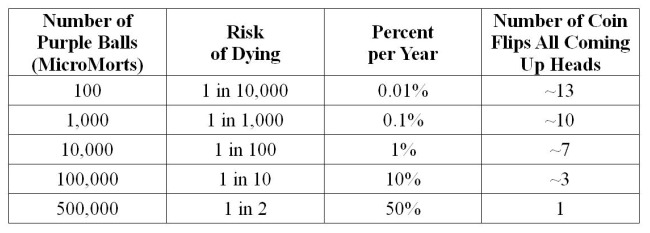Tutorial 2: What Is a MicroMort?
In short, a “MicroMort” is a one-in-a-million chance of dying.
One way to think about a MicroMort is to consider a thought experiment where your mortality fate plays out as a game of chance. Suppose that you had a giant urn filled with one million balls (1,000,000). Some of these balls are purple and some are green. Every year, you reach into the urn and randomly draw a ball. If it is green, you will live one more year, but if it is purple, you will die within the year. We call this thought experiment the purple balls of death, and emphasize that each purple ball represents one chance in a million of dying in the next year – a MicroMort.
DeathRiskRankings.org will tell you how many purple balls someone like you has in their urn. But before using this website, what do you think your risk of dying in the next year is? The table below will help you relate the number of purple balls in your urn to other ways to think about the risk.

Figure 2-1: Purple Balls, MicroMorts, Risk of Dying, Percent Chance of Dying, Coin-flip Equivalent
People do not typically think about risk in this fashion and doing this mental exercise may be difficult, fun, or scary.
You must remember that the MicroMort estimates on this site are based on actual death certificates from the past seven years, and therefore, the website calculates death risks for the average person in each population group (or cohort). The question is, for your, age, lifestyle, and health choices, how many purple balls are in your urn? Depending on your lifestyle, your risk could be dramatically higher (if you are an obese, drunken skydiver) or lower (if you are a vegetarian aerobics instructor) than the values shown, but the results provide a good starting point to think about the risks that you face.
Each purple ball can be tied to some cause of death. Some are related to accidents, some to illness. This website provides MicroMort estimates for up to 66 different causes (the number of causes shown depends on the display that you have selected). You can check to see what the number one cause of death is for your demographic group and see the distribution of the underlying causes of purple balls in your urn (or the urns of any cohorts that you choose to search).
In addition, this website allows comparisons across multiple variables, including age, gender, race, and geographic regions. The geographic comparisons can be done at the individual state level in the US or the country level in Europe or by regions in the US and Europe. For example, how do the death risks compare across age groups for males in California and in France?
The MicroMort concept was first articulated by Stanford University Professor Ron Howard in 1968 and has been used when discussing regulatory risk trade-offs. For more on the concept of a MicroMort and for examples of how it has been used to focus policy debates, the following references will be helpful:
- Professor Ron Howard’s slides on MicroMorts:
http://stanford-online.stanford.edu/sdrmda61w/session10b/slides/sld001.htm - Professor Ron Howard’s 1989 article on medical decision making and MicroMorts:
http://journals.cambridge.org/action/displayAbstract?fromPage=online&aid;=4034472 - Professor David Spiegelhalter’s article in the Times of London on MicroMorts:
http://www.timesonline.co.uk/tol/comment/columnists/guest_contributors/article5696688.ece - Professor Ron Howard’s article in April 1984 issue of Management Science:
http://mansci.journal.informs.org/cgi/content/abstract/30/4/407
